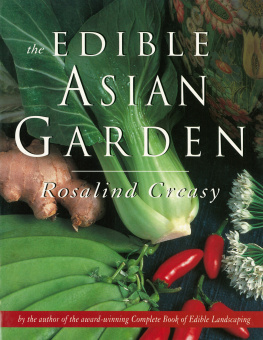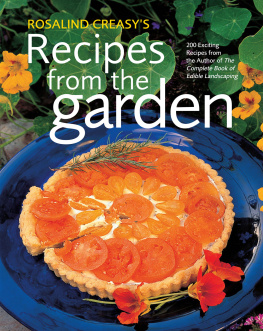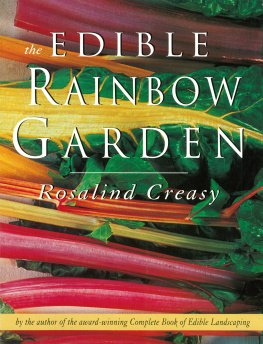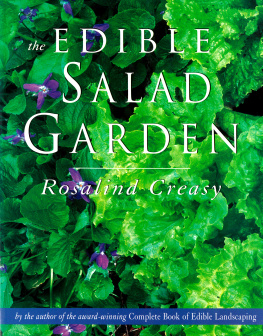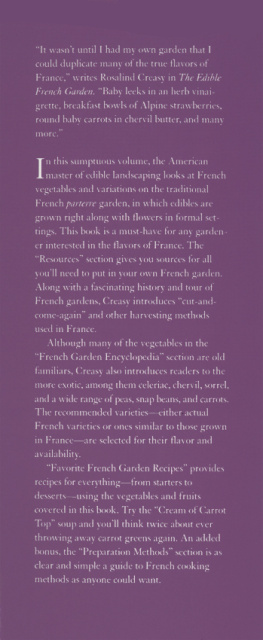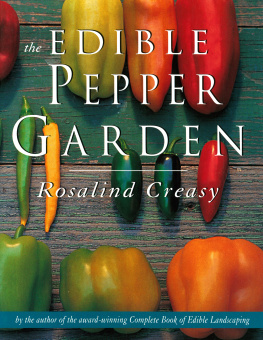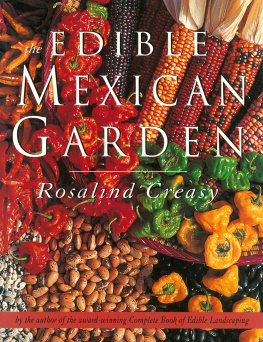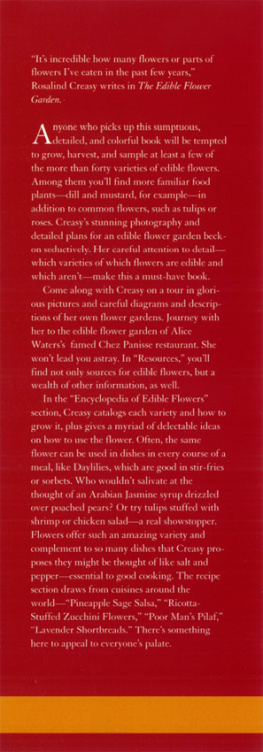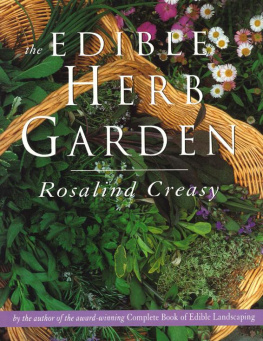acknowledgments
M y garden is the foundation for my books, photography, and recipes. For nearly twelve months of the year we toil to keep it beautiful and bountiful. Unlike most gardens, as it is a photo studio and trial plot, it must look glorious, be healthy, and produce for the kitchen all year. To complicate the maintenance, all the beds are changed every spring and fall. Needless to say, this is a large undertaking. For two decades, a quartet of talented organic gardener-cooks have not only given it hundreds of hours of loving attention but also been generous with their vast knowledge of plants. Together we have forged our concept of gardening and cooking, much of which I share with you in this series of garden cookbooks.
I wish to thank Wendy Krupnick for giving the garden such a strong foundation and Joe Queirolo for maintaining it so beautifully for many years. For the last decade, Jody Main and Duncan Minalga have helped me expand my garden horizons. No matter how complex the project, they enthusiastically rise to the occasion. In the kitchen, I am most fortunate to have Gudi Ritter, a talented cook who sees all new recipes as a welcome challenge. I thank her for the help she provides as we create recipes and present them in all their glory.
I thank Dayna Lane for her steady hand and editorial assistance. In addition to day-to-day compilations, she joins me on our constant search for the most effective organic pest controls, superior vegetable varieties, and the best sources for plants.
Gardeners are by nature most generous. I want to thank Carole Saville, who guides me through the maze of Asian herbs and gives trusted input on recipes. Many seeds people help me amass variety and growing information from all over the county. I particularly want to thank Renee Shepherd of Shepherds Garden Seeds and Rose Marie Nichols McGee of Nichols Garden Nursery.
Over the last three decades, my Asian education has been greatly aided by many friends, neighbors, and professionals. I fortunately live in a part of the world richly populated with people either native to Asia or who are Asian scholars. For years, my daily walks were filled with stories of India and neighbors answering questions like, Whats available in Taiwan? and Does your mother make this in Vietnam? And Asian cookbooks and equipment are willingly loaned. Further, I get to tag along with these patient folks to every sort of Asian grocery store, with guides who not only grew up with most of the vegetables in question but can translate food labels and ask detailed questions of the clerks. My neighbor Cheryl Chang sends seeds from Asia and reports on whats in the markets. In particular, I am most grateful to Arvind and Bhadra Fancy, Helen and Ramsay Chang, and Henry Tran and Mai Truong. Many of their favorite recipes are included in the book. Ellen Brandon, an Asian scholar and devotee of Japanese cooking, has been most generous with information and has shared her library.
Interviews with gardener Peter Chan and chef Ken Hom were of great value, as were conversations and a tour of Chinese markets with chef Barbara Tropp. Being able to share garden experiences with David Cunningham in his Vermont garden gave me confidence that Asian vegetables are oh so adaptable. These peoples vast view of Asian vegetables enriches the information throughout the book.
I would also like to thank my husband, Robert, who gives such high-quality technical advice and loving support.
Many people were instrumental in bringing this book project to fruition. They include Jane Whitfield, Linda Gunnarson, and David Humphrey, who were integral to the initial vision of this book; Kathryn Sky-Peck, who provided the style and quality of the layout, and Marcy Hawthorne, who made the lovely drawings. Heartfelt thanks to Eric Oey and to the entire Periplus staff, especially Deane Norton and Jan Johnson, for their help. Finally, I would like to thank my editor, Jeanine Caunt, for her strong presence, many talents, and dedication to quality.
appendix A planting and maintenance
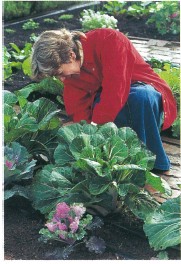
T his section covers the basics of planning a vegetable garden, preparing the soil, starting seeds, transplanting, fertilizing, mulching, composting, installing irrigation, watering, weeding, crop rotation, and using floating row covers.
Planning Your Vegetable Garden
You can interplant Asian vegetables and herbs among your ornamental flowers-many, such as amaranth and peppers, are quite beautifulraise them in large containers or planter boxes; or add them to your existing vegetable garden. If you have no vegetable garden, you can design one. The first step in planning any vegetable garden is choosing a suitable site. Most chefs recommend locating the edible garden as close to the kitchen as possible, and I heartily agree. Beyond that, most vegetables need at least six hours of sun (eight is better)except in warm, humid areas, where afternoon or some filtered shade is best. Most annual vegetables also need fairly rich, well-drained soil with lots of added organic matter.
Take note of what type of soil you have and how well it drains. Annual vegetables need to grow fast and with little stress to be tender and mild. Their roots need air, and if the soil stays waterlogged for long, roots suffocate or are prone to root rot. If you are unsure how well a particular area in your garden drains, dig a hole about 10 inches deep and 10 inches across, where you plan to put your garden, and fill it with water. The next day, fill it againif it still has water in it 8 to 10 hours later, you need to find another place in the garden that will drain much faster, amend your soil with much organic matter and mound it up at least 6 to 8 inches above the ground level, or grow your vegetables in containers. A sandy soil that drains too fast also calls for the addition of copious amounts of organic matter.
Find out, too, what your soil pH is. Nurseries have kits to test your soils pH and a university extension service can lead you to sources of soil tests and soil experts. Most vegetables grow best in soil with a pH between 6.0 to 7.0in other words, slightly acidic. As a rule, rainy climates have acidic soil that needs the pH raised, usually by adding lime, and arid climates have fairly neutral or alkaline soil that needs extra organic matter to lower the pH.
Once youve decided on where you are going to plant, its time to choose your vegetables. Your major consideration is, of course, what flavors you enjoy using in the kitchen. With this in mind, look for species and varieties that grow well in your climate. As a rule, gardeners in northern climates and high elevations look for vegetables that tolerate cool or short summer conditions. Gardeners in hot, humid areas require plants that tolerate diseases well and must carefully choose heat-tolerant vegetables.
The USDA Plant Hardiness Zone Map has grouped eleven zones according to winter lows, a help in choosing perennial plants but of limited use for annual vegetables. Of more interest to the vegetable gardener is the AHS Plant Heat-Zone Map, published by the American Horticultural Society. The heat map details twelve zones that indicate the average number of days each year when a given area experiences temperatures of 86F or higherthe temperature at which many plants, including peas and most salad greens, begin to suffer physiological damage. In The Encyclopedia of Asian Vegetables, I indicate which varieties have a low tolerance to high temperatures and those that grow well in hot weather. See the Bibliography for information on obtaining the heat map.
Crop placement must also be considered. Take care not to plant tall crops, such as cucumbers, on a trellis where they will shade sun-loving plants, such as peppers. Setting out a plan for crop rotation is wise at this point, too. (See the Crop Rotation entry on page .)

